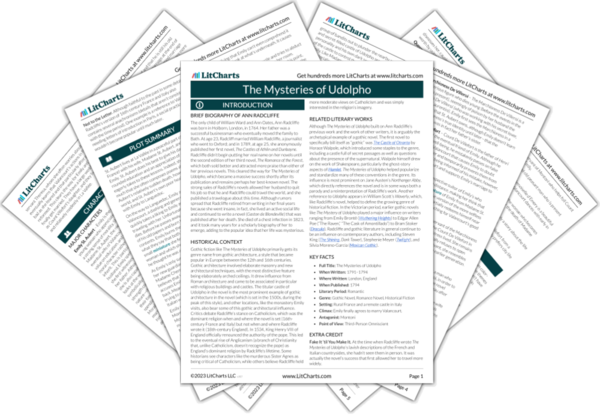Marriage, Love, and Inheritance
In Ann Radcliffe’s The Mysteries of Udolpho, both the heroic and the villainous characters spend much of their time thinking about marriage. For the protagonist Emily, marriage is about love and companionship. She gets these ideas about marriage from her father, St. Aubert, who declined opportunities to make a strategic marriage to increase his wealth, instead marrying Madame St. Aubert due to her friendliness and love for him. When Emily meets the…
read analysis of Marriage, Love, and InheritanceThe Wonders of Nature
The Mysteries of Udolpho contains lavish descriptions of the French and Italian countryside, and the heroic characters take time to appreciate this beauty while the villains tend to lock themselves away from it. Emily, the novel’s protagonist, is often so overwhelmed by the splendor of nature that she can’t help reciting or composing poetry about it. Emily finds that spending time in nature is not just enjoyable but moral—it’s a way to get closer…
read analysis of The Wonders of NatureMystery and Superstition
The Mysteries of Udolpho is, as the title suggests, full of mysterious and creepy events that, for much of the novel, the characters struggle to explain. Emily, despite her education, often believes that that the things she sees or hears have supernatural explanations, and her faithful servant Annette is even more suggestible. Dark figures seem to constantly wander just at the edge of Emily’s vision, and she often hears music without being able to…
read analysis of Mystery and Superstition
Mortality
Death hangs over The Mysteries of Udolpho, as Emily has to face her parents’ deaths (St. Aubert and Madame St. Aubert) and her aunt (Madame Cheron). Perhaps the most visible symbol of mortality in the novel is an old wax statue of a decaying corpse, covered by a black veil of silk (which recalls mourning clothes). The statue was initially a way for the original members of the Udolpho family…
read analysis of MortalityThe Value of Education and Art
From an early age, St. Aubert places an emphasis on giving Emily a good education. His instruction is well-rounded, as he teaches Emily about science, literature, nature, music, and drawing. He provides her with several musical instruments and encourages her to express her creativity through poems. As St. Aubert notes at one point, his philosophy is that an educated mind protects a person not only from ignorance but also from vice. Emily’s prudent decision-making when…
read analysis of The Value of Education and Art






